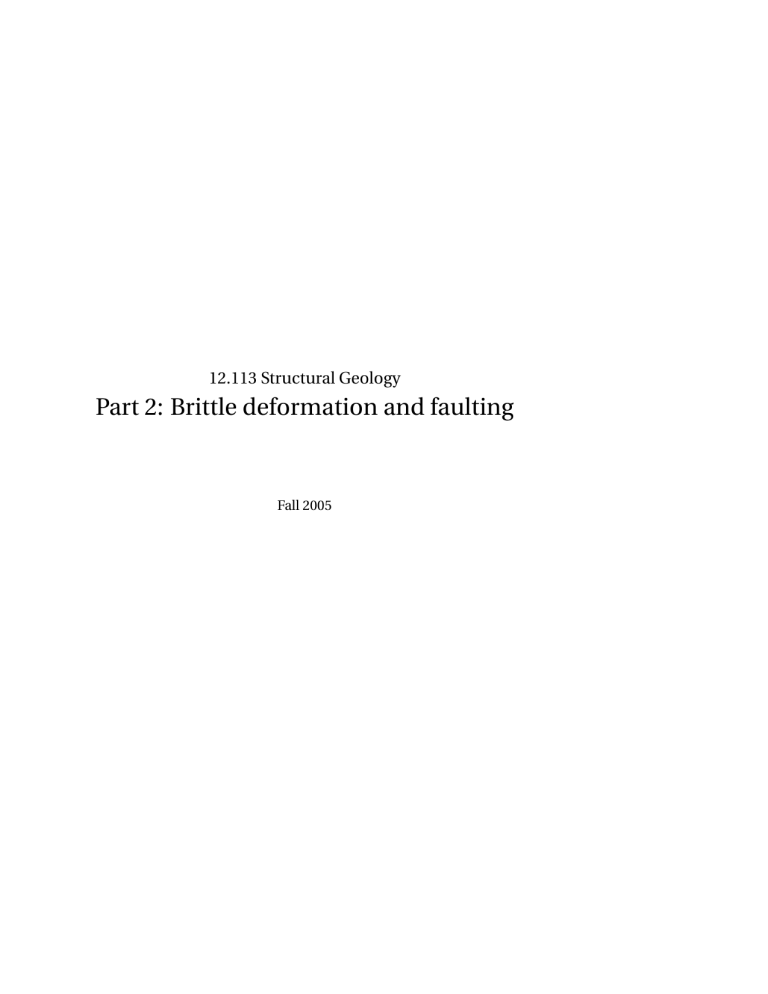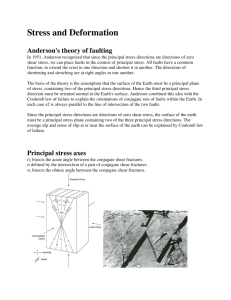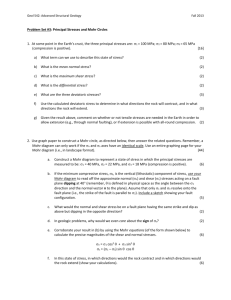Document 13518689

12.113
Structural Geology
Part 2: Brittle deformation and faulting
Fall 2005
2
Contents
1 Brittle material behaviour 5
1.1
Reading assignment . . . . . . . . . . . . . . . . . . . . . . . . . . . . . .
5
1.2
Failure criteria . . . . . . . . . . . . . . . . . . . . . . . . . . . . . . . . . .
5
1.2.1
Tensile stress . . . . . . . . . . . . . . . . . . . . . . . . . . . . . . .
5
1.2.2
Shear fractures in noncohesive material . . . . . . . . . . . . . .
6
1.3
Cohesive material . . . . . . . . . . . . . . . . . . . . . . . . . . . . . . . .
6
1.4
Effect of pore fluid pressures . . . . . . . . . . . . . . . . . . . . . . . . .
7
1.5
Review questions . . . . . . . . . . . . . . . . . . . . . . . . . . . . . . . .
7
2 Faults – General 9
2.1
Reading assignment . . . . . . . . . . . . . . . . . . . . . . . . . . . . . .
9
2.2
Terminology . . . . . . . . . . . . . . . . . . . . . . . . . . . . . . . . . . .
9
2.3
Stress distributions, faulting and tectonic setting . . . . . . . . . . . . .
9
2.4
Slides . . . . . . . . . . . . . . . . . . . . . . . . . . . . . . . . . . . . . . .
10
3
4
Chapter 1
Brittle material behaviour
1.1
Reading assignment
Twiss and Moore’s chapter nine is essential reading for this stuff, and parts of chapter ten are definitely relevant.
1.2
Failure criteria
1.2.1
Tensile stress
σ
1
= σ
2
>> σ
3
And σ
3 ular to σ
3
.
is negative.
Open tension fractures containing σ
1 and σ
2 and perpendic
Draw a Mohr circle for this situation:
S1 shear stress
S2 extension fractures open parallel to sigma
3 !!
S3 normal stress
Figure 1.1: Mohr construction for tensile stresses
5
1.2.2
Shear fractures in noncohesive material
For instance, loose sand.
Byerlee in the 50s conducted various experiments look ing at the strength of these sorts of materials, where strength is understood as the amount of shear stress necessary to initiate motion, given a certain amount of nor mal stress.
If you plot shear stress necessary to initiate motion against normal stress, you get a line which makes an angle φ with the normal stress axis.
The equation de scribing this relationship is Byerlee’s law , and written as
τ c
=
σ
N tan φ
=
µσ
N where φ is called the angle on internal friction and µ is the coefficient of fric tion.
We can create a Mohr construction that illustrates how this equation provides a physical law for predicting when failure will occur in a material:
N
Figure 1.2: Mohr construction for shear failure according to Byerlee’s law (no cohe sion).
As an exercise, label the figure with τ , σ
N
, 2 α , α , σ
1
, σ
3
, and phi .
Also, use this diagram to derive the relationship α
= 45 +
φ /2
1.3
Cohesive material
Given the above failure criterion, in the absence of a confining stress, the shear stress for failure will be zero.
But materials have strength even in the absence of confining stress – this is known as the cohesion .
A modified failure criterion incorporating this is the MohrCoulomb failure criterion:
τ = C + σ
N tan φ
Draw the Mohr circle construction for this.
6
shear stress fai lur e e nv elo pe fluid pressure normal stress
Figure 1.3:
1.4
Effect of pore fluid pressures
The effect of a pressurized fluid on a fault plane is to decrease the normal stress by that pressure.
In this case, the MohrCoulomb failure criterion becomes
τ
= C +
σ
N e f f tan φ
= C + ( σ
N
− P f
) tan φ where P f is the fluid pressure.
On a Mohr diagram, the effect of fluid pressure is to shift the Mohr circle to the left of the diagram.
As fluid pressures go up, the possibil ity that the Mohr circle intersects the failure envelope is increased.
1.5
Review questions
Lab 1 on stress, particularly the orientation of principal stresses in relation to fault types and tectonic environments.
Lab 5 on faults, particularly the problems on joints and Downie’s slide.
What does a generalized failure envelope taking into account both tensile and shear failure look like?
In general, what is the effect of higher mean stress (pressure)?
What implications does this have for the brittle failure of materials at greater and greater depths?
7
8
Chapter 2
Faults – General
2.1
Reading assignment
Chapter 4 is essential reading.
There’s a lot of terminology: I suggest you make a glossary for yourself, adding little cartoons helps, too.
For the discussion of stress distributions, see section 10.9, pages 202 – 205.
2.2
Terminology
For the following terms, write yourself a definition, or, better, draw a cartoon or find a representative figure.
slip vs.
separation slickensides , slickenlines fault scarps , faultline scarps breccia , gouge .
conjugate faults
Drag folds , shift .
Dipslip faults: reverse (thrust) , normal .
Strikeslip faults: rightlateral , leftlateral .
2.3
Stress distributions, faulting and tectonic setting
Rock mechanics and Anderson’s theory of faulting give us a first order picture of how the types and orientations of faults are related to the orientations of principal stresses.
In particular, this was the subject of an exercise in the first lab on stress, and in the lab about faults.
The idea follows from the results of rock deformation ex periments, where it has been observed that shear fractures occur as conjugate sets such that the greatest principal stress bisects the conjugate shear fractures.
Since the Earth’s surface must be a principal plane of stress (no shear stresses are trans mitted across the Earth’s surface), Anderson fault theory predicts that normal faults occur where the greatest principal stress is vertical, thrust faults occur where the least principal stress is vertical and strikeslip faults occur where both greatest and least principal stresses are horizontal.
Since the greatest principal stress is usually at an acute angle to the shear fractures, this also predicts that normal faults ought to be steep, and thrusts are shallow.
However, there definitely are steep thrust faults
(reverse faults) and very low angle normal faults.
Part of this results from the in herent uncertainty and imprecision of the MohrCoulomb model of fault formation, but part of it has to do with the fact that stress orientations ought to change with depth.
9
Figure 2.1: From Twiss and Moore, see textbook for discussion
Consider a "free body" diagram where a compressive tectonic stress is added to the standard state of stress (pressure due to rock thickness increases linearly with depth).
If this stress is sufficiently high, you will get faulting, but stress trajectories are straight lines.
More importantly, if you consider the addition of shear stresses at the base, much more interesting stress orientations result.
Horizontal shear stresses have to be balanced by vertical shear stresses and all shear stresses must vanish at the surface.
The result is that the free body diagram shows curved stress trajectories and a much wider variety of predicted fault orientations.
As an exercise, take the diagrams of stress trajectories and draw on the expected orientations of faults.
2.4
Slides
For each of the slides, take a pen and draw on the fault or faults, and interpret them: what kind of fault, active or not, what kind of structure.
Can you tell slip or just sep aration?
Write a caption for each figure.
10
Figure 2.2:
Figure 2.3:
11
Figure 2.4:
Figure 2.5: The San Andreas fault
12
Figure 2.6: Faulted alluvial material.
Figure 2.7: Sagpond on active fault.
13
Figure 2.8: Note that the fault surface is not quite planar.
The cylindricity of the fault surface is an important indicator of the kinematics of motion
14
Figure 2.9: Slickensides
Figure 2.10: Fault gouge
15
Figure 2.11: Huge thickness of gouge at Tucki mountain, Death Valley, CA.
16
Figure 2.12: Mylonite.
Fault gouge, fracture and fault breccia are all expressions of brittle failure.
Mylonites are produced by ductile deformation mechanisms and are the deep, hot equivalent of brittle faults.
Figure 2.13: The Keystone fault
17
Figure 2.14: Another view of the Keystone fault.
Red rocks are the Jurassic Aztec sandstone.
Dark grey rocks are the Cambrian Bonanza King dolostone.
What is the nature of the contact?
What is the direction of transport?
18




